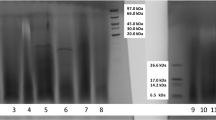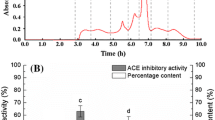Abstract
Brown alga (Undaria pinnatifida) was treated with alginate lyase and hydrolyzed using 17 kinds of proteases and the inhibitory activity of the hydrolysates for the angiotensin-I-converting enzyme (ACE) was measured. Four hydrolysates with potent ACE-inhibitory activity were administered singly and orally to spontaneously hypertensive rats (SHRs). The systolic blood pressure of SHRs decreases significantly after single oral administration of the brown alga hydrolysates by protease S ‘Amano’ (from Bacillus stearothermophilus) at the concentration of 10 (mg protein) (kg body weight)−1. In the 17 weeks of feeding experiment, 7-week-old SHRs were fed standard diet supplemented with the brown alga hydrolysates for 10 weeks. In SHRs fed 1.0 and 0.1% brown alga hydrolysates, elevating of systolic bloodpressure was significantly suppressed for 7 weeks. To elucidate the active components, the brown alga hydrolysates were fractionated by 1-butanol extraction and HPLC on a reverse-phase column. Seven kinds of ACE-inhibitory peptides were isolated and identified by amino acid composition analysis, sequence analysis, and LC-MS with the results Val-Tyr, Ile-Tyr, Ala-Trp, Phe-Tyr, Val-Trp, Ile-Trp, and Leu-Trp. Each peptide was determined to have an antihypertensive effect after a single oral administration in SHRs. The brown alga hydrolysates were also confirmed to decrease the blood pressure in humans.
Similar content being viewed by others
References
Astawan, M., M. Wahyumi, T. Yasuhara, K. Yamada, T. Tadokoro, et al., 1995. Effects of angiotensin I-converting enzyme inhibitory substances derived from Indonesian dried-salted fish on blood pressure of rats. Biosci. Biotech. Biochem., 59: 425–429.
Hata, Y., K. Nakajima, J. Uchida, H. Hidaka, and T. Nakano, 2001. Clinical effects of brown seaweed Undaria pinnatifida (brown alga) on blood pressure in hypertensive subjects. J. Clin. Biochem. Nutr., 30: 43–53.
Kajimoto, O., T. Nkano, T. Hahara, Y. Kajimoto, and T. Takahasi, 2002. Hypotensive effects of brown alga peptides containing jelly on mild hypertensive subjects. J. Nutr. Food, 5: 67–81.
Li, Q., T. Suzuki, M. Sato, K. Mori, and M. Osada, 1998. Degradation of vitellin during embryonic and larval development in the Pacific oyster Crassostrea gigas. In vertebr. Repr. Dev., 33: 1–9.
Maruyama, S., H. Mitachi, J. Awaya, M. Kurono, N. Tomizuka, et al., 1987. Angiotensin I-converting enzyme inhibitory activity of the c-terminal hexapeptide of asl-casein. Agirc. Biol. Chem., 51: 2557–2561.
Matsui, T., H. Matsufuji, E. Seki, K. Osajima, M. Nakahsima, et al., 1993. Inhibition of angiotensin I-converting enzyme by Bacillus licheniformis alkaline protease hydrolyzates derived from sardine muscle. Biosci. Biotech. Biochem., 57: 922–925.
Miyoshi, S., H. Ishikawa, T. Kaneko, F. Fukui, H. Tanaka, et al., 1991. Structures and activity of angiotensin-converting enzyme inhibitors in an α-zein hydrolysate. Agric. Biol. Chem., 55: 1313–1318.
Nakagomi, K., H. Ebisu, Y. Sadakane, N. Fujii, T. Akizawa, et al., 2000. Properties and human origin of two angiotensin I-converting enzyme inhibitory peptides isolated from a tryptic hydrolysate of human serum albumin. Biol. Pharm. Bull., 23: 879–883.
Nakamura, Y., N. Yamamoto, K. Sakai, A. Okubo, S. Yamazaki, et al., 1995. Purification and characterization of angiotensin I-converting enzyme inhibitors from sour milk. J. Dairy Sci., 78: 777–783.
Ondetti, M.A., B. Rubin, and D.W. Cushman, 1977. Design of specific inhibitors of angiotensin-converting enzyme: new class of orally active antihypertensive agents. Science, 196: 441–444.
Sato, M., T. Hosokawa, T. Yamaguchi, T. Nakano, K. Muramoto, et al., 2002a. Angiotensin I-converting enzyme inhibitory peptides derived from brown alga (Undaria pinnatifida) and their antihypertensive effect in spontaneously hypertensive rats. J. Agric. Food Chem., 50: 6 245–6 252.
Sato, M., T. Oba, T. Yamaguchi, T. Nakano, T. Kahara, et al., 2002b. Antihypertensive effects of hydrolysates of brown alga (Undaria pinnatifida) and their angiotensin I-converting enzyme inhibitoryactivity. Ann. Nutr. Metab., 46: 29–37.
Suetsuna, K., 1998. Isolation and characterization of angiotensin I-converting enzyme inhibitor dipeptides derived from Allium sativum L. (garlic). J. Nutr. Biochem., 9: 415–419.
Yamamoto, N., M. Maeno, and T. Takano, 1999. Purification and characterization of an antihypertensive peptide from a yogurt-like product fermented by Lactbacillus helveticus CPN4. J. Dairy Sci., 82: 1388–1393.
Yamamoto, S., I. Toida, and K. Iwai, 1980. Re-examination of the spectrophotometric assay for serum angiotensin-converting enzyme. Nippon Kyoubu Shikkangaku Kaishi, 18: 297–303.
Author information
Authors and Affiliations
Corresponding author
Rights and permissions
About this article
Cite this article
Minoru, S., Takashi, O., Takao, H. et al. Production of the blood pressure lowing peptides from brown alga (Undaria pinnatifida). J Ocean Univ. China 4, 209–213 (2005). https://doi.org/10.1007/s11802-005-0034-2
Received:
Accepted:
Issue Date:
DOI: https://doi.org/10.1007/s11802-005-0034-2




